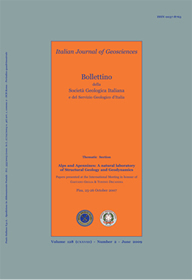
New data on post-Eocene tectonic evolution of the External Ligurian Briançonnais (Western Ligurian Alps)
Fabrizio Piana(*), Alessia Musso(**), Carlo Bertok(**), Anna d'Atri(**), Luca Martire(**), Elena Perotti(**), Dario Varrone(*) & Giorgio Martinotti(**)
(*) CNR, Istituto di Geoscienze e Georisorse, via Valperga Caluso, 35 - 10125 Torino, Italy; f.piana@csg.to.cnr.it; d.varrone@csg.to.cnr.it.
(**) Dipartimento di Scienze della Terra, Università degli Studi di Torino, via Valperga Caluso, 35 - 10125 Torino, Italy; carlo.bertok@unito.it; anna.datri@unito.it; giorgio.martinotti@unito.it; luca.martire@unito.it; alessia.musso@unito.it; elena.perotti@unito.it.
Volume: 128 (2009) f.2
Pages: 353-366
Abstract
A new structural setting for the central part of the External Ligurian Briançonnais (CELB) is proposed. CELB is divided into km-scale tectonic units that still preserve pre-Alpine geological features at several stratigraphic levels. Macro-, meso- and microscale primary features, such as paleoescarpments, unconformities and depositional or diagenetic fabrics are thus well preserved and can be still mapped and studied in detail at many stratigraphic levels.
Significant transposition of bedding is recorded only in Upper Cretaceous and Eocene marly limestones and shales and in major km-long shear zones, where intense development of closely spaced tectonic foliations occurred.
Several features indicate that the CELB tectonic evolution took place at shallow crustal levels: 1) strong localization of deformation along the weakest stratigraphic levels; 2) absence of diffuse recrystallization of rocks; 3) minor occurrence or absence of transposition of bedding; 4) kinematic evolution of fold axial plane foliations into frictional slip cleavages.
A gradual decrease in the intensity of deformation from the Internal Ligurian Briançonnais to CELB and Dauphinois Domain is observed, although the boundaries of these three domains correspond, in the study area, to several Km-long, transpressive shear zones whose kinematic role in the evolution of the southern termination of the Western Alps should be carefully considered.
Keywords
Ligurian Briançonnais Domain, Meso-Cenozoic carbonate succession, Alpine transpressive tectonics, palaeofaults.
Get Full Text